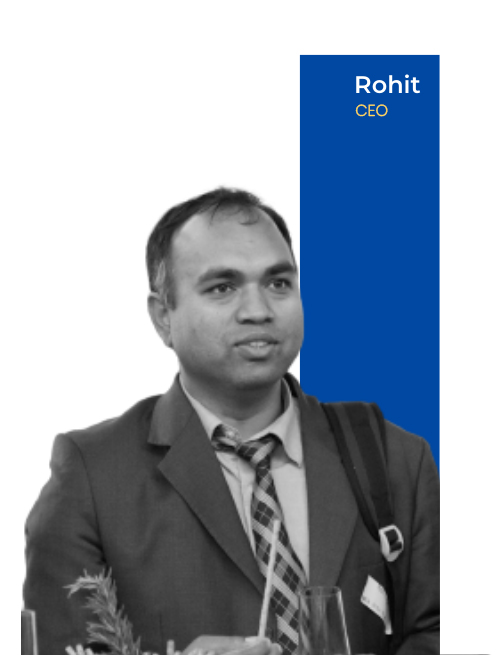Rohit Kumar is responsible for Researchwire European & North American business. He is an HEC, Paris 2008 MBA and Indian Institute of Technology (IIT) Kharagpur 2002 engineering graduate with close to 17 years of experience in business innovation and strategy, business development and client relationship roles. He is working with ResearchWire since 2016 and as a partner, is responsible for the growth of ResearchWire in Europe and North America.
Prior to ResearchWire, Rohit was handling sales strategy and pricing for Syniverse Technologies, a telecom services provider, where he was instrumental for growth in EMEA and India through product innovations, creative pricing and discounting models and executing strategic sales plans.
Rohit is based out of Luxembourg and has been living in Europe for last 12 years. He understands European & North American customers and their needs and ensures that our customers always have a local person to reach out whenever needed.
Why was Web2 considered data economy? Conceptually, how is it different from Web3?
Does Web3 has the potential to transform how data is organized and connected across platforms to resolve social issues?
Web2 was characterised by the platform economy and was primarily controlled by big tech companies. All user-created content was stored on their own centralised database. There was no option of transferability of content from the registered network and its operator. Content was always tied to a specific network. Most data were being shared and used for monetisation. Thus, Web2 was seen as the data economy. It produced products and services that users had to accept. It maximised data extraction from users but not provide innovative, creative and user-friendly features to them.
Unlike Web2, there are unlimited opportunities to explore in Web3, characterised by decentralisation, cryptography and blockchain. It is still evolving and the proponents claim that their vision for internet can eliminate giants and middlemen by completely decentralizing the web. Such disruptive technologies are impactful and affect other technologies as well. It can be best seen as a technology that disrupts the status quo of an industry or a market and has a novelty factor attached to it. Blockchain is one of the most advanced technologies in recent times. It has incredible implications and positively impacts several industries. It performs the role of a digital ledger and can prevent cheating and hacking. One can track the progress of goods in the supply chain or verify the ownership of an artwork. So, there are a large number of applications dedicated to blockchain in the world of IP in the current times.
In the new phase of Web3, it is possible to mobilise and incentivise communities to do certain acts of social good and create significant positive impact. Working in the Web3 space enable teams to remove complexity and build tools in the regional frameworks or languages for developers. This enables them to onboard, start creating and innovating within the Web3 space. They can continue to update and provide unique mechanics in the dynamic market. In Web3, it is possible to track progress, from a global standpoint as well as understand how this space is developing. Web3 can use its strengths (access, ownership, community) to create equitable opportunities and positive societal impact.
Web3 also has several potential applications across industries aimed to solve ownership issues surrounding privacy, self-sovereignty, and economics within the internet.
By leveraging tokens, cryptography, and decentralised technology, Web3 aims to disrupt the centralised, intermediary monopolistic business structures. Legal experts however, feel that IP and patents will have an awkward fit in Web3 decentralization. Within Web3 and NFT, IP rights will perpetually be in conflict zones since IP rights often rely on single identities whereas Web3 is more decentralized. Over the previous years, several lawsuits have been filed against NFT projects that have allegedly violated IP and copyright.
In the Web3 format, technology enables different types of functionalities to streamline the entire process, remove middlemen and offer opportunities for artists to make a living in a society where people are passionate and supportive of their craft. These interrelationships create an environment for individuals to shine; and it is individual excellence that drives an organisation’s performance and profitability. In this space, users can develop ways to own their data available on different platforms and not be entirely dependent on one provider. (Digi)citizens need not just trust and rely on a single entity with their data. In the context of social media too, no single tech giant will have control over individual freedom of speech, displayed online content and user behaviour.
Since blockchain utilises the distributed ledger technology, it has the ability to record, share, and synchronise transactions in their respective electronic ledgers,it can potentially be used as a platform where inventors can store their information in the form of ledgers with a note describing their invention. It can act as an IP marketplace where potential licensees will get to know about inventions and the patent holders/inventors.
As th market continues to innovate, economics will start to change and Web3 will be seen as more mainstream. It will be necessary to understand Web3, and plan an interface with Web3. Entrepreneurs need to search for their opportunity and how to make the most of it. Web3 startups must analyse and explore Web3 product needs in terms of Intellectual Property and how to structure IP asset protection to avoid potential infringements.
Largely, core developers are active in this space and curious to learn more. Also, several organisations are eager to be educated on how they can integrate Web3 in this early phase and keep it open ended thereafter, so that they can continue to build on their early initiatives and move forward.
It is necessary to educate and empower technical teams within an organisation and help an individual or decentralised developer teams with specific tools that will enable them to build quicker and iterate.
There are no fixed criteria for mastering the Web3 space. There may be established brands that could be too slow to move into this space and there can be visionary leaders that could be a part of a more agile company, or simply entrepreneurs who have more freedom to move into this space. This depends not just on how the business is set up and structured, but also what is their community like? What is the audience and how will this community respond to this new change? Will they accept and move ahead with the initiative? How will digital identity, branding, Intellectual Property and protection through blockchain technology integrate in the creator economy? The users can decide if Web3 will reward and empower their community. So, Web3 use can provide the ability to mobilise and incentivise communities towards social goods in an inclusive atmosphere.
This space can also provide several tools for developers, provide ideal innovation space to explore new ideas, as well as provide unique mechanics. It can help businesses to focus on business logic and reduce the role of middleman.
In Web3 space, there are two kinds of tokens used – social tokens and Non-Fungible Tokens (NFTs). If one has a unique digital object, it is referred to as an NFT. Social tokens are essentially not unique objects. They could be replaced with any other hence they are fungible. Social tokens are tiny micro-economies of their own cryptocurrency. In Web3 space, creators are allowed to launch, manage, and grow their own digital economies.
These tokens can be used as reward points or reward systems; a unique feature of a token economy, as opposed to maybe, a more traditional point system. Here, the rewards can go both ways. For example, a creator can reward his follower base for specific actions for joining their discord server, or for retweeting something that they had shared. They can reward their followers with a social token, and they can also render them opportunities to spend that social token for rewards, or benefits, that the follower base might like or want to use.
Hence, Web3 can help create economies not just by driving value out of followers’ money through businesses, and then reaching creators, but actually create economies that essentially have their own mutually benefiting economy that can operate within a community. So, in Web3 the big focus is centred around communities that revolve around a creator. It aims to make the end product accessible and affordable to more people.
In this mutual partnership, people who come up with great ideas that benefit their community can build that application. Their application is often shared with other creators and can be approved if unique, useful and innovative.
New ways for empowering communities
Cryptocurrency and blockchain technologies can yield social good by creating financial and educational opportunities for disadvantaged communities.
Decentralised Autonomous Organizations (DAOs) are online, automated, decentralised communities that aim to distribute decision-making, management, and entity ownership. They allow community governance by avoiding external influences and can be applicable across a wide range of assets and organisations, i.e., platforms for executing proposals, creating Apps, funding investments. Aave, Curve DAO and Web3 Familia are popular examples of successful DAOs.
Web3 Familia was started with the goal to onboard over one million Latinos worldwide onto Web3. It began by engaging with people who were crypto-curious. Today, the organisation has reached a level where it educates institutional investors and venture capitalists who wish to learn about blockchain and plan to deploy capital well in the current economic system. In Web3, this type of intersection between communities and investors is possible and has great potential.
These developments suggest that the next generation of Web3 adopters are going to be people interested in knowing more about what technology can do for them. Where can blockchain technology be used and what kind of community welfare can be achieved, will remain as key focus in Web3.
Future of cryptocurrency for social good
Several organisations, projects, and individuals will use Web3 to create real-world impact. They are leading the innovative and powerful ways of connecting NFT creators and non-profits for environmental awareness and fundraising. Projects working with underprivileged communities will create more teams to help several groups. This will include services like educating investors, business leaders, and financial institutions about blockchain and crypto. It will also include consultations on how to invest in the creators, communities, and builders who are most deserving. It is the responsibility of all entities and individuals in power to emphasise and act on building equity – so companies and leaders are no different. Web3 protocols aim to keep their resource providers and users happy and engaged by extending the platform’s opportunities and by ensuring shared rewards and ownership.
So, Web3 brings along decentralisation of platforms, networks and systems creating more community friendly data and applications. It is certain to pave the way for vast frameworks that will encourage developers to build more user-friendly apps for social good, socio-economic growth and community development. Centralised data management by a few companies and platforms cannot be visualised in the coming years. Web3 is moving ahead to the mainstream, overtaking existing businesses, creating new but massive markets and transforming them.



